March 11 - April 19, 2015
Six Weeks / Six Exhibitions / Twelve Artists
Susan Schelle, "Solitaire" (1991). Wood, paint, needlepoint. 6” x 5”. Walter Phillips Gallery, Banff Centre. Photo by Meghan Krauss.
For six weeks Walter Phillips Gallery was converted into a mini-exhibition space to highlight works from Banff Centre's Permanent Collection. Each week featured a new pairing of artworks that are seldom seen and rarely thought of in relation to one another. Through the peculiar alliances of artworks, the exhibition revealed the diverse nature of the collection, which is both rich and eclectic in theme and medium. The Odd Couple celebrates the union of artworks that live alongside each other in the collection; some who have shared quarters for decades, if not longer.
Week 1
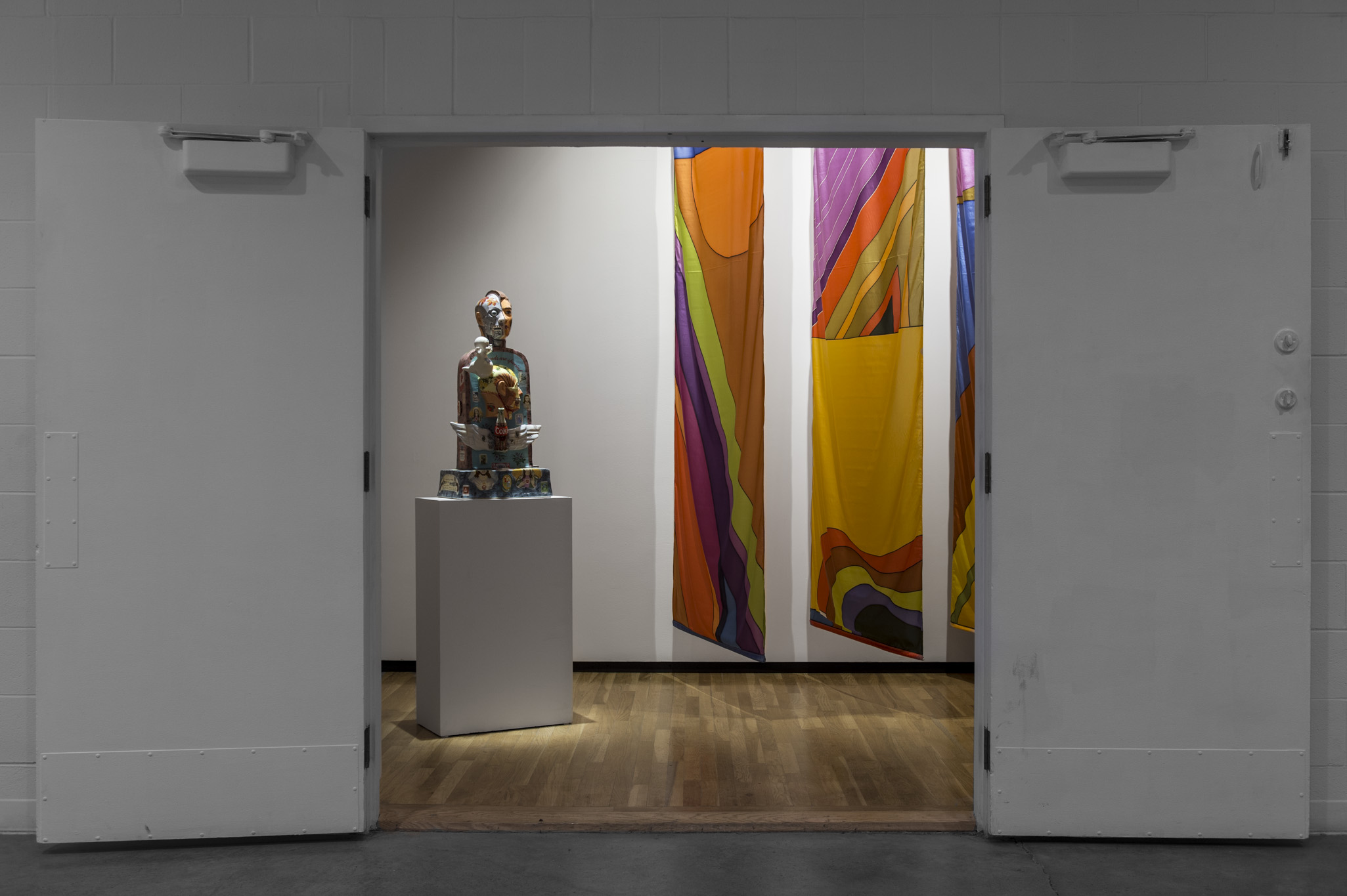
Installation view of Takao Tanabe, ``Untitled *3 Nylon Banners*`` (1978) and John de Fazio, ``PMS Tombstone`` (1996). Walter Phillips Gallery, Banff Centre. Photo by Meghan Krauss.
March 11 – 16, 2015
Takao Tanabe and John de Fazio
Takao Tanabe (b. British Columbia Canada, 1926)
Untitled *3 Nylon Banners*, 1978
Silkscreen on nylon
324 cm x 105 cm
Acquired 1978
John de Fazio (b. Los Angeles USA, 1975)
PMS Tombstone, 1996
Glazed earthenware with china paint and ceramic decals
84 cm x 43 cm x 41 cm
Acquired 1996
Primarily known for his abstracted and elemental landscapes, Takao Tanabe’s Untitled *3 Nylon Banners* are indicative of his earlier abstract paintings (1965-1970) that also feature large swathes of colour and geometric shapes. Importantly, Tanabe spent almost a decade at Banff Centre, as the head of Visual Arts (1973 - 1980) and as an artist-in-residence. His tenure helped lead The Banff School of Arts away from summer-long classes toward extended residencies for professional, post-graduate artists. Untitled *3 Nylon Banners* is a result of an intense period of production in Banff, where Tanabe began working with textiles. This striking series of banners, almost like vertical flags, abstract the landscape; folding, reflecting and enveloping different elements into one another. The formal reduction of the sky, the land, the mountains are depicted here in full primary union. Their very material, a light airy nylon fabric, is also permeable to the elements, moving with the wind, or the body as you walk through them.
John de Fazio has produced an idiosyncratic body of work that blends themes of pop culture with classical mythologies. de Fazioʼs work centers on mixed-media sculptures that objectify pivotal moments in contemporary culture. Versed in a multitude of formats and visual languages, de Fazio’s practice often focuses on personal narratives exploring decay, fragility, and love, and its influence on the human consciousness. His work is a mechanism to face fear and love. de Fazio’s 1996 work, PMS Tombstone was made in Banff while on residence, and is indicative of this duality; the human bust depicted is sliced down the middle to reveal culture’s impermeable and haunting influence on our consciousness.
While PMS Tombstone and Untitled *3 Nylon Banners* are visually diverse – one abstract and the other figurative and chaotic – they invite the viewer to experience and understand their human-scale, made curiouser by a close vicinity to them. Similar in vibrancy of colour, both hark back to techniques that are seeing a resurgence of late, with pseudo-decoupage ceramics and textile-making brought out of retro kitsch into contemporary art. This is the first time these delicate works have been on display since they were acquired.
John de Fazio Biography
John DeFazio is a Los Angeles based cinematographer, film-maker and artist. DeFazio has shot for numerous Hollywood directors such as Joe Dante (director of "Gremlins"), Paul Schrader (director of "American Gigolo" and screenwriter of "Taxi Driver" & "Raging Bull") and Roger Corman (producer of "Death Race", "Little Shop of Horrors"). His work has been shown at the Venice Biennale and at Museum of Art and Design, New York, and is in the collections of the Whitney Museum of American Art and The Museum of Fine Arts, Houston
Takao Tanabe Biography
Takao Tanabe's work is in numerous public, corporate and private collections
including: Art Gallery of Greater Victoria; Art Gallery of Ontario; Canada
Council Art Bank; Glenbow Museum, Calgary; National Gallery of Canada; Tate
Museum, U.K.; Vancouver Art Gallery; Jarislowsky, Fraser and Co.; Scotiabank;
UBS Canada. Tanabe is the recipient of several honorary degrees and awards
including Order of Canada (Member) and the Governor General's Award in Visual
and Media Arts.
Week 2
Susan Schelle, "Solitaire" (1991). Wood, paint, needlepoint. 6” x 5”. Walter Phillips Gallery, Banff Centre. Photo by Meghan Krauss.
March 18 – 23, 2015
Susan Schelle and Nina Raginsky
Susan Schelle (b. Ontario, Canada, 1947)
Wood, paint, needlepoint
6” (L) x 5” (W)
Nina Raginsky (b. Montreal, Canada, 1941)
The Kirkpatrick Sisters at the Empress Hotel (Victoria, BC), 1975
Hand coloured toned silver print
17cm (H) x 11.45cm
Solitaire is composed of nine small foot stools, each covered in a hand-embroidered design. The footstools are arranged on a glass-topped plinth. The exhibition of these seemingly purposeless objects is curious, removed as they are from their typical companion, the armchair. The work highlights the largely unacknowledged labour performed by the footstool, giving this supporting object a starring role. Each cushion is embroidered in black and white, and with imagery of solitary, common household objects: a camera, reading glasses, a domino, a dress, an envelope, a keyhole. In mixing associations with the domestic through the use of household imagery and the feminized technique of needlecraft, Solitaire invites the viewer to ask who, or what, is supported by these feminized objects, the furniture in the room?
Susan Schelle Biography
Susan Schelle has been exhibiting since 1978. Her sculptural photo based works confront issues of the museum culture, collecting, cataloguing and researching as well as domestic life and the natural world. Her work has been shown nationally and internationally including the Clock Tower New York, Albright College, Pennsylvania and the Vancouver Art Gallery. Her works are in many private and public collections including the Art Gallery of Ontario, the Canadian Museum of Contemporary Photography, Ottawa , and the Winnipeg Art Gallery.
Nina Raginsky Biography
Nina Raginsky studied at Rutgers University, receiving her BA in 1962. During her distinguished career, the artist has had solo exhibitions at the San Francisco Museum of Art and the Art Gallery of Ontario. Raginsky is in the collection of the National Gallery of Canada and the National Film Board of Canada, and was made an Officer of the Order of Canada in 1985.
Week 3
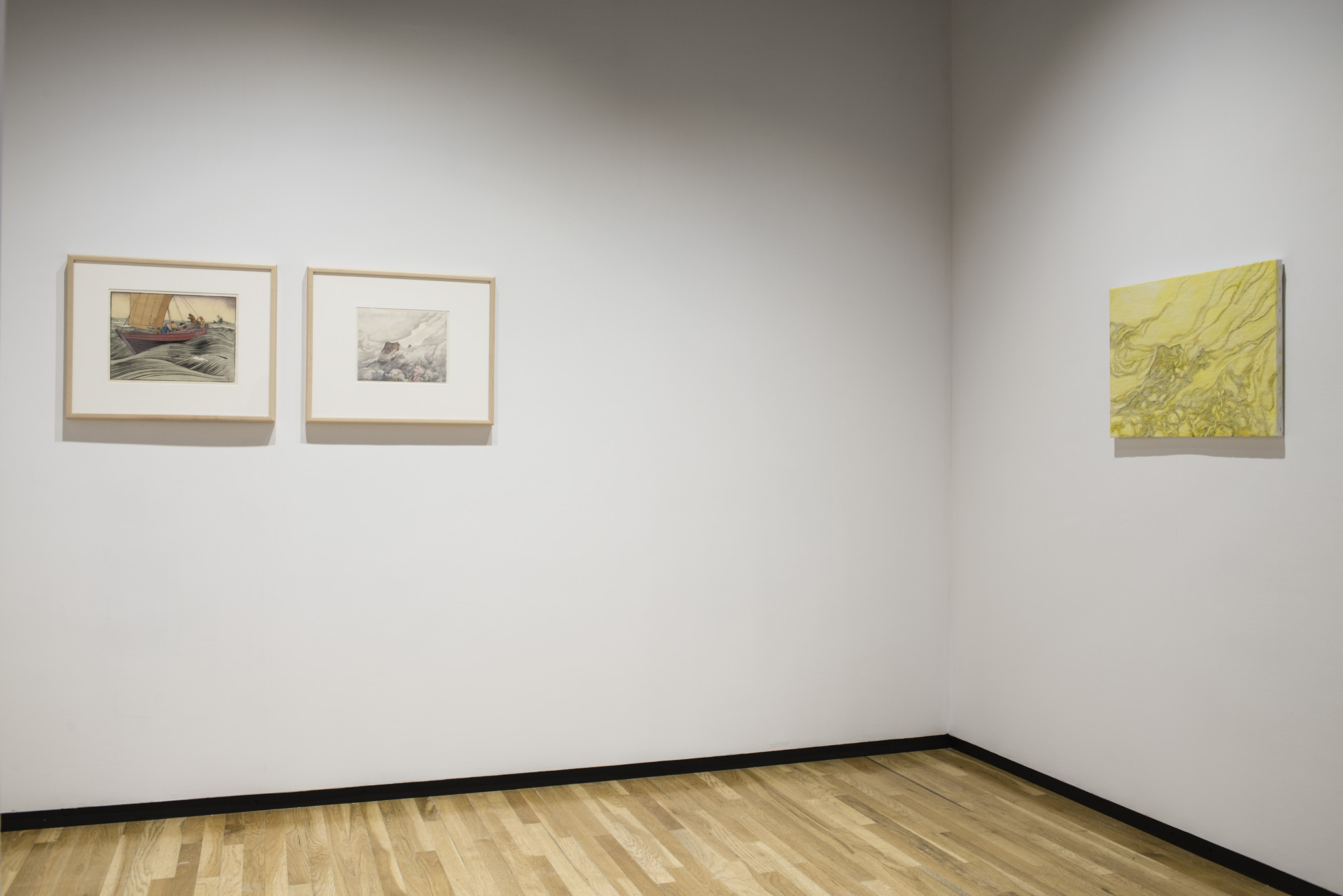
Installation view of week three of "The Odd Couple" (2015). Walter Phillips Gallery, Banff Centre. Photo by Meghan Krauss.
Week Three: March 25 – 30, 2015
Walter J. Phillips and Allan Harding MacKay
Walter J. Phillips (b. Lincolnshire, England, 1884; d. British Columbia, Canada, 1963)
York Boat on Lake Winnipeg (52/120), 1930
Colour woodblock print
36cm x 27cm
Acquired 1978
Walter J. PhillipsVapour Round the Mountain Curled, 1938
Watercolour
36cm x 27cm
Acquired 1978
Allan Harding MacKay (b. Prince Edward Island, Canada, 1944)
Vapours after WJP, 1998 (from Source/Derivations VI series)
Oil, wax, and pencil on canvas
18cm x 60.9cm
Acquired 2002
Allan MacKay’s Source/Derivation VI series was produced while on residence at Banff Centre. The series initially began by MacKay choosing a ‘source’ image from another artist and responding to it by creating a ‘derivation’. Commonly focused on themes of cultural identity and place, his interest in the work of other artists stemmed from a desire to acknowledge the past as an important ‘source’ of possible alternatives for the future. His sixth iteration in this series is specifically in homage to three of Walter J. Phillips’ paintings. The work Vapours after WJP (1998) is in direct response to Phillips’ Vapours Round the Mountain Curled (1938). The artistic recording of the Canadian landscape is a long held tradition in the nation’s art history and has been significant in shaping its identity, as well as its important role as a commodity in the Canadian economy. MacKay’s abstract re-recording of the landscape through Phillips’ objective depiction once again reorients our relationship to the land. Specifically his use of oil and wax in his work questions the extraction and use of natural resources that inextricably alter our landscape.
As Walter Phillips Gallery’s namesake, Phillips was a recognized authority in the medium of woodblock print making. The work York Boat on Lake Winnipeg is a quintessential example that emphasises the strong line and subtle colouring so indicative of his work. Though originally a watercolourist, Phillips became inspired by woodblock printing early in his career, and it wasn’t long before he sought to merge these mediums. The combined effect of the bold line work and the fluid application of colour create a movement and an energy that transcends, reflecting the power and beauty of the Canadian landscape that was so influential to Phillips’ work. While Allan MacKay wasn’t specifically influenced by this work, there is a peculiar similarity between the three works; the fluidity of the line and energy of both of the sky and waves in Phillips’ pieces are translated through the movement in the tactility of MacKay’s homage.
Walter J. Phillips Biography
Walter Phillips was a Canadian artist well known for his watercolour paintings and hand coloured woodblock prints that commonly depict the lakes of Manitoba, the prairies and the Rocky Mountains. Phillips was an artist-in-residence at Banff Centre in 1940 and continued to teach here until 1959. He was instrumental in the development of the Visual Arts Program and his work is in the collections of The National Gallery of Canada, The Glenbow Museum and the Whyte Museum of the Canadian Rockies. His piece York Boat on Lake Winnipeg is featured in the 1997 Canada Post “Masterpieces of Canadian Art” stamp series.
Allan Harding MacKay Biography
Allan MacKay’s work features in numerous collections locally, nationally and
worldwide, including: The National Gallery of Canada; Canadian War Museum;
Confederation Centre Art Gallery; The Art Gallery of Nova Scotia; City of
Calgary Regional Arts Foundation; Whyte Museum of the Canadian Rockies; and the
Kunstmuseum in Bern, Switzerland. MacKay’s diverse career has credited him with
experience as an artist, gallery director, curator and arts administrator. He
has been an artist-in-residence at the Banff Centre several times between 1986
and 2001.
Week 4
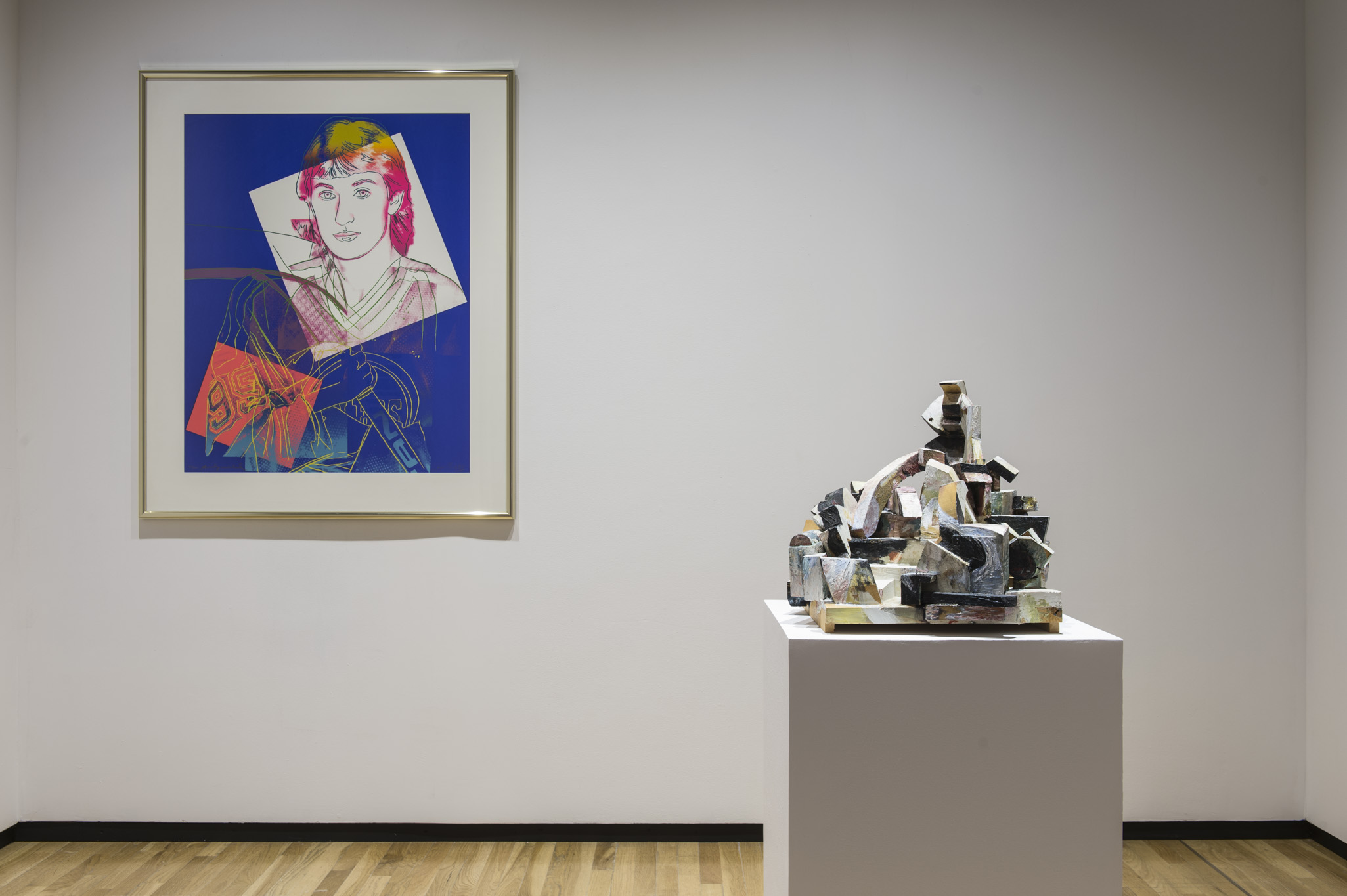
Installation view of week four of "The Odd Couple" (2015). Walter Phillips Gallery, Banff Centre. Photo by Meghan Krauss.
Week Three: March 31 – April 2, 2015
Carroll Taylor-Lindoe and Andy Warhol
Carroll Taylor-Lindoe (formerly Moppett - b. Calgary, Canada, 1948)
Figure in Landscape, 1983
Wood, plaster, paint, canvas
53 cm x 46 cm x 57 cm
Andy Warhol (b. Pittsburgh, USA, 1928)
Wayne Gretzky 99, 1984
Acrylic silkscreen print
82 cm x 102 cm
Carroll Taylor-Lindoe’s Figure in Landscape (1983) is from a series of works that blur the boundaries of painting and sculpture. After a walk in Calgary’s Bow River Valley, Taylor-Lindoe was struck with the vast natural landscape that was immediately in the vicinity of downtown Calgary. Interested in the physical investigation of traversing the landscape juxtaposed with the controlled manner in which the brutalist and modern architecture of the business district was navigated, she created Figure in Landscape. By reducing the landscape and the city down to its most basic forms – lines, tones, colours, and shapes – she created a new environment. Detaching the object from a specific location – both geographically and in space – Taylor-Lindoe has allowed the object to be viewed from multiple perspectives, similar to the way in which you experience the landscape on a walk. Her process of assemblage of environments is also augmented by the way in which she employs pseudo-impressionist painting techniques on a cubist, purely abstracted form.
In 1983 the Canadian gallerist Frans Wynans commissioned Andy Warhol to produce a series of six portraits of hockey star Wayne Gretzky as part of a campaign to raise the profile of the Canadian art market. The commission came shortly after the celebrated ‘Athlete Series’, which for Warhol reflected the changing nature of celebrity in American popular culture, with athletes like jockey William Shoemaker or soccer player Pele featured in earlier iterations. At the time Wayne Gretzky was at the height of his career, having just won the Stanley Cup after having been bought a few years earlier by Peter Pocklington, the long-time owner of the Edmonton Oilers and co-commissioner of the Warhol prints. Wayne Gretzky 99 (1984) differs from the earlier works in the ‘Athlete Series’, as the screenprint features a fragmented assemblage of layers. Unlike the older works, Wayne Gretzky 99 has several competing layers of colour that includes photo-montage, block uses of colour and line work. The split framing of his face on white background gestures towards the official style of sporting team portraiture and his famous ‘99’ jersey creates an odd perspective that abstracts his body in the image.
Both works point towards an overtly 1980s aesthetic. While rendered in two opposing styles – one painterly and the other bold graphics – Wayne Gretzky 99 and Figure in Landscape render the landscape and the body into a series of shapes and forms, ostensibly flattening the image. Both works could be seen as portraits of figurative subjects that are dwarfed by landscapes – one tangibly brutalist and architectural and the other commercial and celebrity-driven.
Carroll Taylor-Lindoe Biography
Carroll Taylor-Lindoe (formerly Moppett) has exhibited widely in numerous group and solo exhibitions in both public and private galleries in a career spanning more than four decades. Her work can be found in many public and private collections across Canada. Included among these are the National Gallery of Canada, the Edmonton Art Gallery, the Glenbow Museum (Calgary), the Winnipeg Art Gallery, the McMichael Collection, and the Department of Foreign Affairs and International Trade, Ottawa, as well as major corporate collections and commissions.
Andy Warhol Biography
More than twenty years after his death, Andy Warhol remains one of the most influential figures in contemporary art and culture. Warhol’s life and work inspires creative thinkers worldwide thanks to his enduring imagery, his artfully cultivated celebrity, and the ongoing research of dedicated scholars. His impact as an artist is far deeper and greater than his one prescient observation that “everyone will be world famous for fifteen minutes.” His omnivorous curiosity resulted in an enormous body of work that spanned every available medium and most importantly contributed to the collapse of boundaries between high and low culture.
Week 5
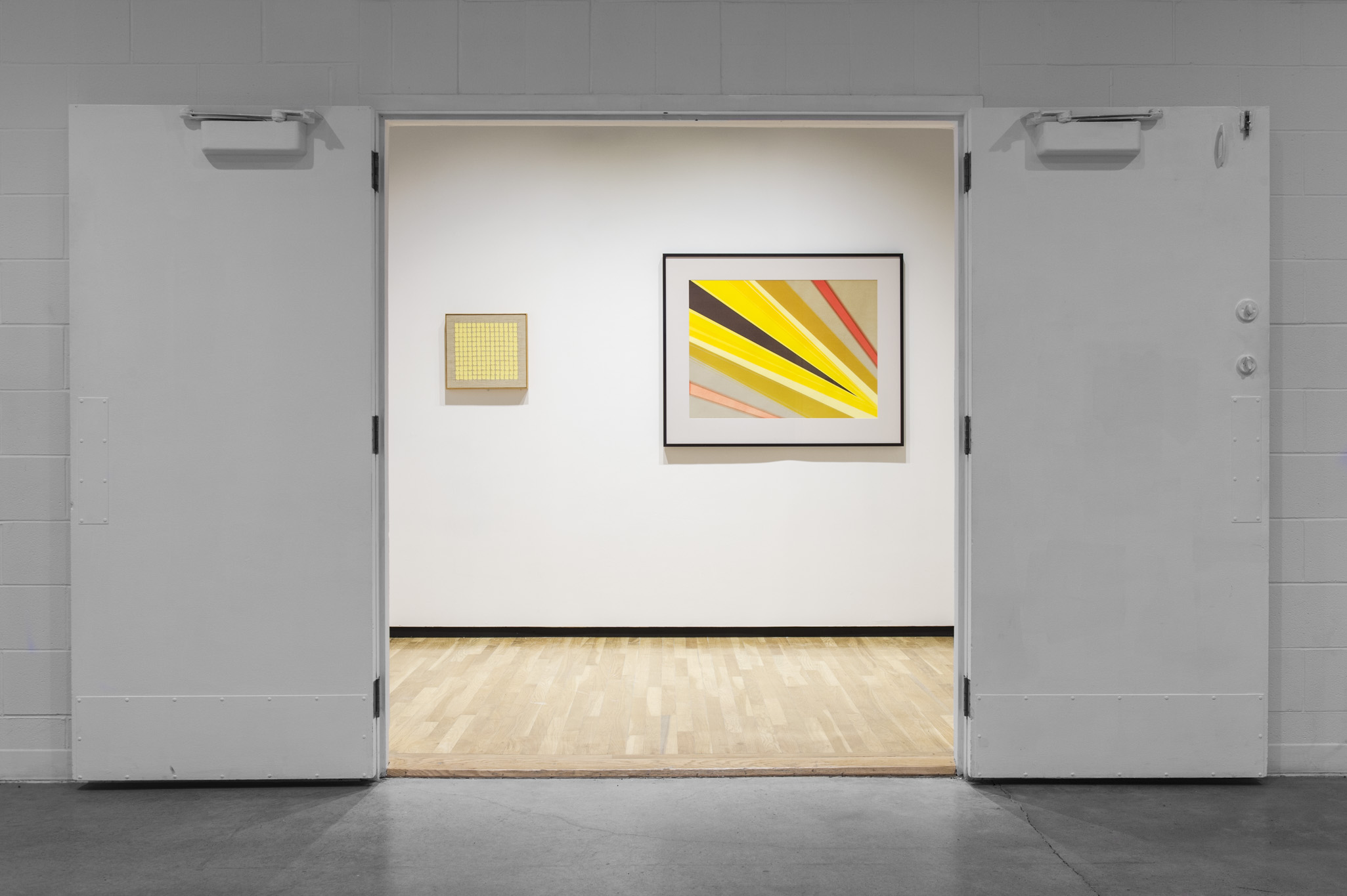
Installation view of week four of "The Odd Couple" (2015). Walter Phillips Gallery, Banff Centre. Photo by Meghan Krauss.
Week Five: April 7 - 14, 2015
Barbara Todd and Rita Letendre
Barbara Todd (b. 1952, Galt, Ontario)
Untitled *Yellow Squares*, 1982
16” x 15”
Mixed media
Rita Letendre (b. 1928, Drummondville, Quebec)
Zahara (49/50), 1973
48” x 38 ¼”
Print on paper
In the late nineteen eighties and early nineteen nineties, artist Barbara Todd produced a series of quilted textile works titled Security Blankets. The works were produced in a wool fabric typically used in men’s suits, and featured imagery of missiles, war planes and bombs; imagery unlikely to be adorning the quilt’s domestic cousins. This darkly playful series twins the associations of ‘domestic security’ to reference both the militarized state and the domestic scene. A number of the quilts In Security Blankets were comprised of “quilt blocks”; squares of fabric that are typically then stitched together to form a grid. Todd’s quilts wryly politicize this grid, a form often associated with a dominant modernist art history, while at the same time nodding to the masculine overtones of its use through re-making it in a material often associated with the domestic. Produced prior to the Security Blankets series, Untitled *Yellow Squares* could be considered an earlier critique by Todd of the modernist associations of the grid. The painting is comprised of yellow paint dotted on raw canvas, a playful regimentation of the singular ‘dab’ of paint into the repetitive structure.
Rita Letendre’s work Zahara might similarly be understood as a reaction to particular modernist sensibilities in painting, as well as to regionally specific conversations. In the years prior to producing the work Zahara, the artist was exhibiting as a part of the Automatistes group of artists in Montreal, led by the painter Paul-Émile Borduas. This work displays the style that Letendre would become internationally recognized for; a hard edged line, graphic sensibility and use of multiple bright shades. The mirrored graphic lines that fill the picture plane are seemingly broken open by a wedge of color, forcing the straight lines to become frames on either side. The form of the wedge, a cut of color, is repeated in many of the artist’s works from this period; characterizing Letendre’s “sustained confrontation with the picture plane that results in a tearing of the modernist ‘image screen’”.[1]
Barbara Todd Biography
Barbara Todd is an interdisciplinary artist who has received acclaim for her textile and quilt based works. Her work has been featured in museums, private collections and public commission spaces, in Canada and the U.S. Todd divides her time between Troy, New York, and Montreal, where she teaches in the Studio Arts Department at Concordia University. In 1981, she moved to Banff, Alberta where she lived and worked at Banff Centre for the following decade.
Rita Letendre Biography
Rita Letendre was born in Drummondville, Quebec, in 1928. The artist is of Abenaki descent, and has produced work for over six decades. Her early paintings were associated with the Automatiste group in Montreal during , but shifted to a more hard-edged, non-figurative style. Hard use of lines and geometric color blocks are often associated with her work. Her work are included in many public and private collections globally, including The National Art Gallery of Canada, Ottawa, the Museum of Contemporary Art, Montréal, the Art Gallery of Vancouver, the Art Gallery of Ontario, Toronto, Carleton University, Ottawa, and the Long Beach Museum of Fine Arts, California.
Week 6
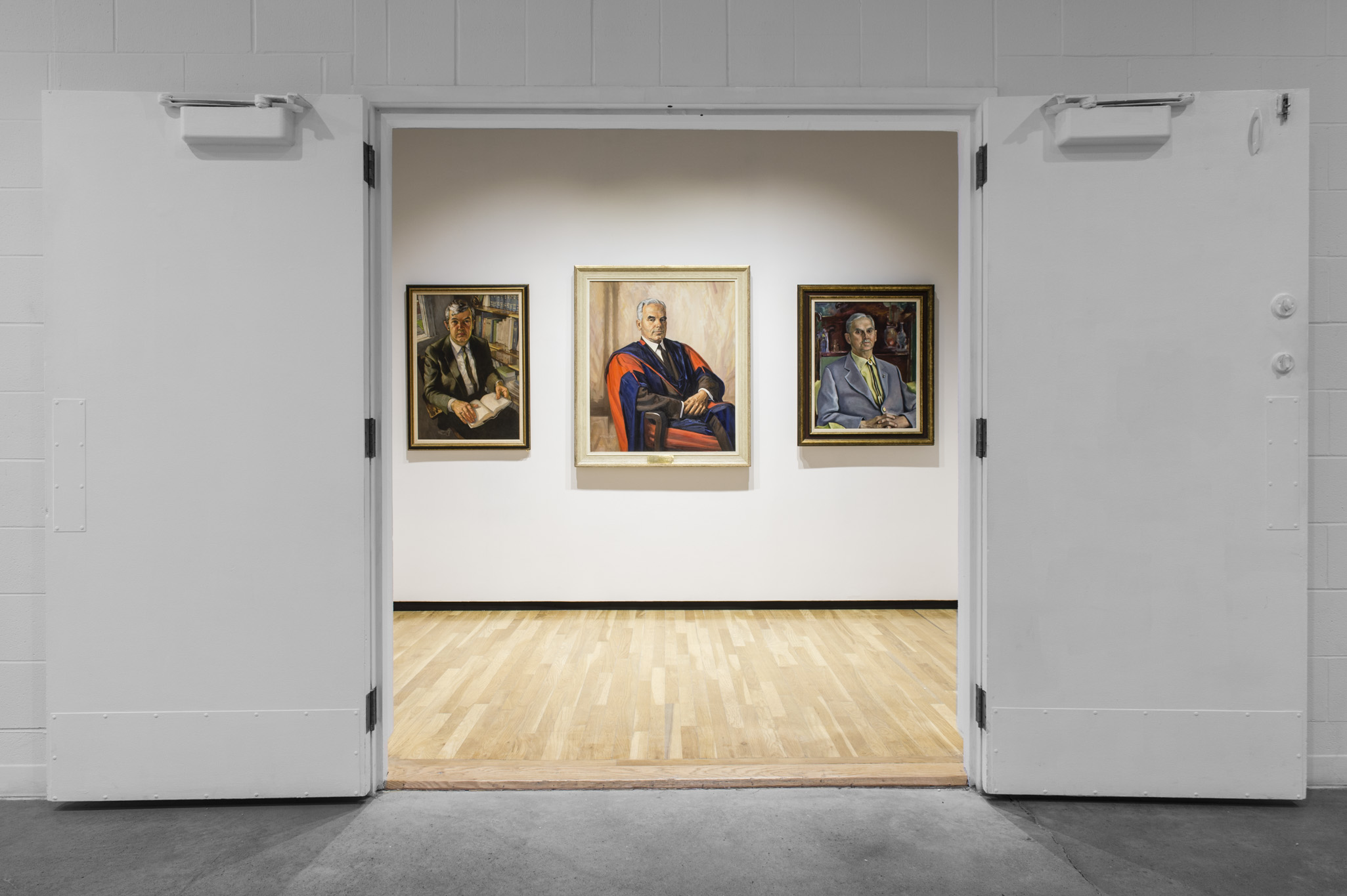
Installation view of week six of "The Odd Couple" (2015). Walter Phillips Gallery, Banff Centre. Photo by Meghan Krauss.
Week Six: April 13 - 19, 2015
Robert S. Hyndman (b. 1915, Edmonton, Alberta; d.2009, National Capital Region, Ontario)
Portrait of Eric Harvie, 1973
76cm x 62cm
Oil on canvas
Janet (Holly) Middleton (b. 1922, Vernon, BC)
Portrait of H. G. Glyde, 1976
96cm x 81cm
Oil on canvas
Winston Elliott (b. 1924)
Portrait of Senator Donald Cameron, acquired 1960
118cm x 104cm
Oil on canvas
Janet (Holly) Middleton (b. 1922, Vernon, BC)
Portrait of Ernesto Vinci, 1975
66cm x 97cm
Oil on canvas
Rudolf Stussi (b. 1947, Zurich, Switzerland)
Portrait of Paul D. Fleck, ?
96 cm x 80 cm
Oil on canvas
This week we couldn’t help ourselves. We have deviated from the rules in the final week of The Odd Couple to include more than two artists. This week the names are familiar, but perhaps not the faces. Displayed are portraits of the founders of The Banff Centre as we know it today; prior presidents, teachers, philanthropists and artists. It also identifies a gap in our collection, which it seems has very little portraiture, let alone portraiture of women. Four artists are represented in this selection, Holly Middleton, who has lovingly rendered portraits of an imaginative Ernesto Vinci of Vinci Hall and Henry Glyde, whose name-sake building you stand in. Robert Hyndman and Winston Elliot were previously war photographers, recognizable in the formal imposing style of Eric Harvie (of Eric Harvie Theatre) and Donald Cameron. Finally, Rudolf Stussi has rendered Paul Fleck in an interesting angle, capturing his thoughtful personalit.
Born in England in 1901, Donald Cameron Jr. and his family immigrated to Canada in 1906 and settled in Elnora, AB. During his working life, Cameron was an academic, author, teacher and politician and held the positions of Professor at the University of Alberta from 1936-1956, head of the Banff School of Fine Arts until 1969 and as a member of the Canadian Senate as an Independent Liberal from 1955-1987. Cameron also helped to found the Banff School of Advanced Management in 1952.
Dr. Paul Duncan Fleck held the position of president of the Banff Centre from 1982-1992. Prior to moving to Banff, Fleck was the president of the Ontario College of Art and the chairman of the English Department at the University of Western Ontario. Fleck had a great passion for the written and spoken word and was instrumental in promoting the reputation of the Banff Centre to international acclaim.
German born Ernesto Vinci moved to North America 1938 at the onset of World War II. As a talented baritone singer Vinci was referred to Wilfrid Pelletier as the potential director of vocals at the Halifax Conservatory of Music. During his career he taught vocals at the RCMT, University of Toronto and gave summer classes at the Banff Centre for the Arts; Vinci soon gained a reputation as one of Canada’s prominent voice teachers.
After graduating from the Royal College of Art, London in 1930, Henry George Glyde moved to Canada in 1935 where he began his teaching career. He taught at the Provincial Institute of Technology and Art in Calgary, the Banff School of Fine Arts in Banff, and established the Division of Fine Art at the University of Alberta. Primarily working in oils, Glyde’s work often depicts urban and rural prairie life in a style dubbed ‘social realism’. Glyde is a member of the Royal Canadian Academy of Arts.
Born in 1892, Eric Harvie is a celebrated Canadian businessman and philanthropist who made his fortune after miners struck a large oil reserve on land he owned the mineral rights to. He proceeded in giving back generously to Canadian people by helping to establish several prominent institutions in Alberta including the Glenbow Museum, the Calgary Zoo and the Banff Centre for the Arts. He was awarded the Order of Canada (for services to the Arts and the community) in 1968 and was inducted into the Calgary Business Hall of Fame in 2012.
-------------------------------------------------------------------------------------------------------------------------
Robert S. Hyndman Biography
Robert Hyndman was a Canadian portrait and landscape artist with an artistic career spanning over 70 years. Hyndman was an official Canadian war artist during World War II with many of these works now on permanent display at the Canadian War Museum. Following the war, Hyndman taught painting at several institutions across Canada including the Banff School of Fine Arts from 1964-1972. He was the recipient of the Art & Heritage Award in 2001 and the Victor Tolgesy Award in 2003 from the City of Ottawa.
Janet (Holly) Middleton Biography
Janet (Holly) Middleton studied art alongside prominent Canadian artists such as H.G. Glyde, Walter J. Phillips and former Group of Seven member A.Y. Jackson. Middleton taught during the summer at the Banff School of Fine Arts from 1948-1971 and her work forms part of many private and public collections including the BC Provincial Government collections at Bakerville Park. She is a member of the Alberta Society of Artists and the Canadian Society of Painters-Etchers and Engravers.
Rudolf Stussi Biography
Born in Switzerland in 1947, Rudolf Stussi moved to Canada in 1967 and graduated from the Ontario College of Art in 1978. Stussi was president of the Canadian Society of Painters in Watercolour (CSPWC) from 1988-1991, was awarded the Julius Griffith Award in 2011 and has been inducted into the Royal Canadian Academy of Arts. His work is shown in galleries throughout Canada, the US, Switzerland, Germany, Austria and Israel.
Winston Elliott Biography
Known primarily for his portraits, Winston Elliott gained recognition as an artist during the Second World War where he painted prominent naval heroes and worked alongside official war artist Grant Macdonald. Following the war Elliott attended the Ontario College of Art where he graduated in 1948. Since leaving college, Elliott embarked on a successful artistic career spanning over 60 years. His works have shown in galleries, and are featured in numerous collections across Canada.